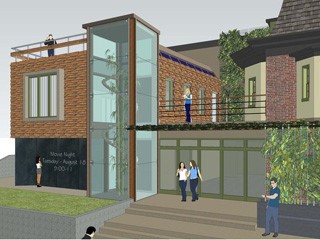Proposed Features
Over the years, there have been several multidisciplinary projects and classes that have worked to design ideas that would turn our house of 35th and Race St. into a real "Smart House." Below are some of the best ideas that came out of these projects but have yet to be implemented in the House.

Community Resource Center
A Community Resource Center open to the public will be a place where homeowners in Powelton Village can get questions answered from knowledgeable students and/or faculty. Information about systems used in the Smart House or general conclusions gathered over time from the research at the Smart House will be available for homeowners to learn what can work best in their own homes to improve the overall quality of living. A library will house references such as guides for techniques on how to achieve energy efficient and environmentally responsible designs and catalogs from local vendors within a 500-mile radius.
Rainwater Harvesting System
The rainwater harvesting systems aims to collect rainwater and prevent storm water from entering Philadelphia’s Combined Sewage Overflow (CSO) system, a major issue the city is set out to resolve. The stored water can be used for irrigation, general daily tasks (flushing toilets, cleaning dishes, watering plants), and is made available for students to test various filtering systems and explore future possibilities for re-using rainwater and greywater. Capturing rainwater reduces waste and saves money spent on water supply.
Drainage from the roof will water planters in the lobby through pipes from the roof before it enters the cistern, as seen in the student generated rendering of the public entrance off of 35th street (Picture coming soon!)+: To the right pipes coming from the roof direct rainwater to planters filled with a specific plant species that improve the indoor air quality. When it rains the plants automatically get watered, and the plants naturally filter the water as it permeates through the soil into a trough where the water is then directed to the rainwater storage tank in the basement.

The Living Water Tower
Rain travels through roof drains and trickles down a series of exposed sculptural “steps” which are visible at the entrance of the building and double as an aesthetic water feature. The rainwater then reaches and fills the same cistern used for the planters in the lobby. The water from the cistern is constantly re-circulated using a solar powered pump back to the top of the roof and then back down through the “Living Water Tower” through drip irrigation lines. This system never allows the water to sit still for too long which could result in bad bacteria formation. Cold water from the underground storage tanks is filtered and pumped up into the building for use in clothes washing, hand washing